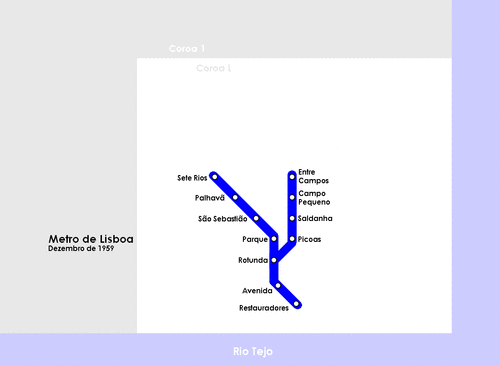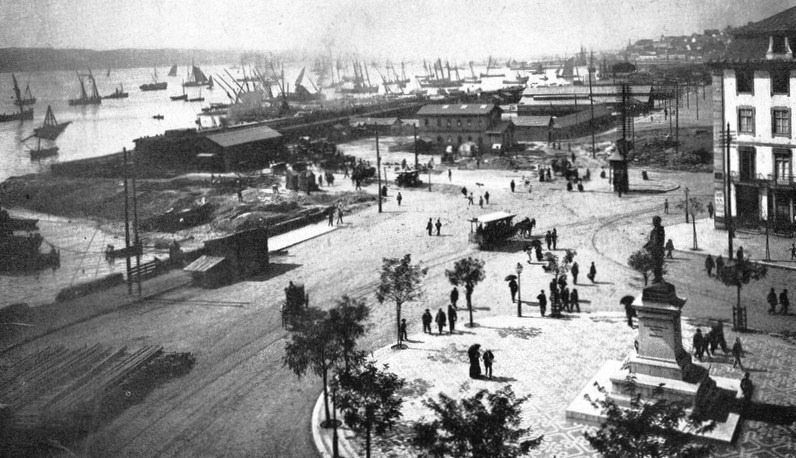|
Rato Station
Rato station is the southern terminus of the Yellow Line of the Lisbon Metro. History The station opened on 29 December 1997 and is located on Largo do Rato. The architectural design of the station is by Sanchez Jorge. Connections Urban buses Carris * Cais do Sodré ⇄ Bairro Padre Cruz * Cais do Sodré ⇄ Estação Santa Apolónia * Restauradores ⇄ Campo de Ourique (Prazeres) * Alameda D. A. Henriques ⇄ Estação Campolide * Picheleira/Rua Faria Vasconcelos ⇄ Calvário * Estação Roma-Areeiro ⇄ Restelo - Av. das Descobertas * Quinta dos Barros ⇄ Alto de Santo Amaro * Cais do Sodré ⇄ Portas de Benfica * Campo de Ourique (Prazeres) ⇄ Gomes Freire See also * List of Lisbon metro stations This is a list of the stations of the metro system in Lisbon, Portugal (see Lisbon Metro). List of stations * Transfer station * Terminal * Transfer station and terminal References {{DEFAULTSORT:List of Lisbon Metro Stations Lisbon ... Ref ... [...More Info...] [...Related Items...] OR: [Wikipedia] [Google] [Baidu] |
Metropolitano Lisboa Logo
Metropolitano S.A. was a privately owned consortium formed in 1994 to take over concessions granted by the Argentina, Argentine government as part of Railway Privatisation in Argentina, railway privatisation during the presidency of Carlos Menem for the operation of commuter rail services in the Buenos Aires Province. Metropolitano operated the San Martín Line (Buenos Aires), San Martín, Roca Line (Buenos Aires), Roca and Belgrano Sur Line (Buenos Aires), Belgrano Sur lines until 2007. History Passenger train, Passenger services on San Martín, Roca and Belgrano Sur lines had previously been run by Government-owned corporation, state-owned company Ferrocarriles Argentinos since Railway Nationalisation in Argentina, nationalisation of the railways in 1948 and then by FEMESA (a provisional company that operated metropolitan train services until the process of privatisation was carried out). The services run by Metropolitano started from termini in or near the city centre and ... [...More Info...] [...Related Items...] OR: [Wikipedia] [Google] [Baidu] |
Lisbon
Lisbon ( ; ) is the capital and largest city of Portugal, with an estimated population of 567,131, as of 2023, within its administrative limits and 3,028,000 within the Lisbon Metropolitan Area, metropolis, as of 2025. Lisbon is mainland Europe's westernmost capital city (second overall after Reykjavík, Reykjavik), and the only one along the Atlantic coast, the others (Reykjavik and Dublin) being on islands. The city lies in the western portion of the Iberian Peninsula, on the northern shore of the River Tagus. The western portion of its metro area, the Portuguese Riviera, hosts the westernmost point of Continental Europe, culminating at Cabo da Roca. Lisbon is one of the List of oldest continuously inhabited cities, oldest cities in the world and the second-oldest European capital city (after Athens), predating other modern European capitals by centuries. Settled by pre-Celtic tribes and later founded and civilized by the Phoenicians, Julius Caesar made it a municipium ... [...More Info...] [...Related Items...] OR: [Wikipedia] [Google] [Baidu] |
Government-owned Corporation
A state-owned enterprise (SOE) is a business entity created or owned by a national or local government, either through an executive order or legislation. SOEs aim to generate profit for the government, prevent private sector monopolies, provide goods at lower prices, implement government policies, or serve remote areas where private businesses are scarce. The government typically holds full or majority ownership and oversees operations. SOEs have a distinct legal structure, with financial and developmental goals, like making services more accessible while earning profit (such as a state railway). They can be considered as government-affiliated entities designed to meet commercial and state capitalist objectives. Terminology The terminology around the term state-owned enterprise is murky. All three words in the term are challenged and subject to interpretation. First, it is debatable what the term "state" implies (e.g., it is unclear whether municipally owned corporations and ente ... [...More Info...] [...Related Items...] OR: [Wikipedia] [Google] [Baidu] |
Yellow Line (Lisbon Metro)
The Yellow Line () or Sunflower Line () is one of the four lines of Lisbon Metro. Stations Odivelas Senhor Roubado Ameixoeira Lumiar Quinta das Conchas Campo Grande Cidade Universitária Entre Campos Campo Pequeno Saldanha Picoas Marquês de Pombal Rato Frequency *Rato - Campo Grande**Campo Grande - Odivelas Chronology *December 29, 1959: Opening of the original Lisbon Metro network with a Y shape. Common branch stations: Restauradores, Avenida, Rotunda (former name of the Marquês de Pombal station and where the line would split into the two branches). Current Blue Line branch stations (coming from Rotunda station): Parque, São Sebastião, Palhavã (former name of the Praça de Espanha station) and Sete Rios (former name of the Jardim Zoológico station). Current Yellow Line branch stations (coming from Rotunda station): Picoas, Saldanha, Campo Pequeno and Entre Campos. * January 27, 1963: Opening of the Rossio station. Main branch r ... [...More Info...] [...Related Items...] OR: [Wikipedia] [Google] [Baidu] |
Side Platform
A side platform (also known as a marginal platform or a single-face platform) is a platform positioned to the side of one or more railway tracks or guideways at a railway station, tram stop, or transitway. A station having dual side platforms, one for each direction of travel, is the basic design used for double-track railway lines (as opposed to, for instance, the island platform where a single platform lies between the tracks). Side platforms may result in a wider overall footprint for the station compared with an island platform, where a single width of platform can be shared by riders using either track. In some stations, the two side platforms are connected by a footbridge or tunnel to allow safe access to the alternate platform. While a pair of side platforms is often provided on a dual-track line, a single side platform is usually sufficient (trains are usually only boarded from one side) for a single-track line. Layout Where the station is close to a level crossing (g ... [...More Info...] [...Related Items...] OR: [Wikipedia] [Google] [Baidu] |
Lisbon Metro
The Lisbon Metro () is a rapid transit system in Lisbon, Portugal. Opened in December 1959, it was the first rapid transit system in Portugal. , the system's four lines total of route and serve 56 stations. History Initial plans The idea of building a system of underground railways for the city of Lisbon first arose in 1888. It was first proposed by Henrique de Lima e Cunha, a military engineer who had published a proposal in the journal ''Obras Públicas e Minas'' ''(Public Works and Mines)'' for a network with several lines that could serve the Portuguese capital. Concrete plans took longer to evolve, though. Lanoel Aussenac d'Abel and Abel Coelho presented theirs in 1923, and José Manteca Roger and Juan Luque Argenti theirs one year later, in 1924. None of these plans were carried out. After World War II, in which Portugal remained neutral, the national economy took off and the financial possibilities arising from the Marshall Plan provided a strong boost to the pote ... [...More Info...] [...Related Items...] OR: [Wikipedia] [Google] [Baidu] |
Cais Do Sodré (Lisbon Metro)
Cais do Sodré is an area in the center of Lisbon, Portugal, between Cais da Marinha and Cais do Gás. This name is shared by two List of railway stations in Portugal, railway stations and a ferry station in Lisbon, Portugal: * Cais do Sodré railway station * Cais do Sodré (Lisbon Metro) * Cais do Sodré, ferry station (allowing for quick travel between Lisbon and Cacilhas, Seixal and Montijo, Portugal, Montijo) History Cais do Sodré was known at the beginning of the 19th century as Bairro dos Remolares. From 1855 onwards, several works were carried out to transform this unhealthy place into a landmark in the city of Lisbon at the time. Warehouses were built, fishing sailors began to live in the neighborhood, entrepreneurs linked to the import and export industry opened businesses in the neighborhood. Everyone benefitted from the proximity of the port and international commercial connections. With the arrival of these groups, Cais do Sodré was already a social reference ... [...More Info...] [...Related Items...] OR: [Wikipedia] [Google] [Baidu] |
Restauradores (Lisbon Metro)
Restauradores station is on the Blue Line of the Lisbon Metro. History It is one of the 11 stations that belong to the original Lisbon Metro network, opened on December 29, 1959. This station is located under Restauradores Square, from which it takes its name, and connects to Rossio Railway Station on the Sintra Line. The architectural design of the original station is by Falcão e Cunha. On February 11, 1977, the station was extended, based on the architectural design of Benoliel de Carvalho. On September 15, 1994, the north atrium of the station was refurbished, based on the architectural design of Sanchez Jorge. On August 8, 1998, the south atrium of the station was refurbished, based on the architectural design of Manuel Ponte. Connections Urban buses Carris * * Cais do Sodré ⇄ Fetais (morning service) * Campo de Ourique ⇄ Restauradores * Terreiro do Paço ⇄ Alto da Damaia * Marquês de Pombal ⇄ Caselas * Cais do Sodré ⇄ Odivelas (Bairro Dr. ... [...More Info...] [...Related Items...] OR: [Wikipedia] [Google] [Baidu] |
Alameda (Lisbon Metro)
Alameda is a station on the Green and Red Lines of the Lisbon Metro. The station is located on Avenida Almirante Reis at Alameda Dom Afonso Henriques, east of the Instituto Superior Técnico. History This section of the Green Line opened in June 1972 together with Arroios, Areeiro, Roma and Alvalade stations. The original architectural design of the station was by Dinis Gomes with installation art by the plastic artist Maria Keil. Full refurbishment of the station was completed in March 1998, which involved extending the piers of the existing station for the construction of the Red Line. The architect for this project was Manuel Tainha and the artist was Luís Noronha da Costa. The Red Line station opened in May 1998 in conjunction with Olaias, Bela Vista, Chelas and Oriente stations, with a view to extending the network to the area of Expo '98. The architectural design for this is also by Manuel Tainha and the art work by plastic artists Costa Pinheiro and Juhana Blomsted ... [...More Info...] [...Related Items...] OR: [Wikipedia] [Google] [Baidu] |
List Of Lisbon Metro Stations
This is a list of the stations of the metro system in Lisbon, Portugal (see Lisbon Metro). List of stations * Transfer station * Terminal * Transfer station and terminal References {{DEFAULTSORT:List of Lisbon Metro Stations Lisbon Lisbon ( ; ) is the capital and largest city of Portugal, with an estimated population of 567,131, as of 2023, within its administrative limits and 3,028,000 within the Lisbon Metropolitan Area, metropolis, as of 2025. Lisbon is mainlan ... Transport in Lisbon Metro stations ... [...More Info...] [...Related Items...] OR: [Wikipedia] [Google] [Baidu] |



